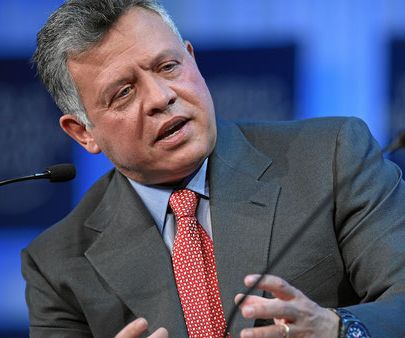 Article by Shehab and Maria Al Makahleh
Article by Shehab and Maria Al Makahleh
It is significant for a Syrian opposition member to take a photo with a top American official. When the US Secretary of State Rex Tillerson held a meeting in Jordan’s capital, Amman, with the head of the Syrian Negotiations Commission, Nasr al-Hariri, and an accompanying delegation on February 14, the photo, which went viral, signaled how Jordan is set to play a major role in the outcome of ongoing conflicts in the tumultuous Middle East. Indeed, the meeting suggested that Amman is emerging as an increasingly influential actor following the decision made by US President Donald Trump last year to recognize Jerusalem as the Israeli capital.
Thus, the American official’s visit to Amman was well-received in the Hashemite Kingdom where the leadership is eyeing a new role in Syria. This new role is in line with Jordan’s current one in the American-Russian pact vis-à-vis the de-escalation zones. Washington sent Tillerson days after US Vice President Mike Pence’s visit to Amman. King Abdullah II voiced Jordan’s concerns and trepidations about the ramifications of Trump’s policies vis-à-vis the Palestinian-Israeli conflict, which many Jordanians fear will undermine stability in the Hashemite Kingdom.
The Jordanian monarch’s message reached Washington, which sent Tillerson to Jordan for primarily three main reasons. The first was to strengthen US-Jordan relations in a host of domains from security to economics and mil-mil cooperation. The second was to signal support for Amman’s new role in the Syrian crisis as a host of the moderate Syrian opposition which embraces the idea of finding a political solution to the seven-year conflict. The third was to back Jordan’s role in talks between the Palestinians and Israelis.
Although Tillerson’s message to the Jordanians (and other Arabs too), which he made through his meeting with the King of Jordan, was that the Trump administration’s position on Jerusalem is not currently effective and will take years to crystallize. Yet the top American diplomatic chief’s message failed to assuage King Abdullah II’s concerns as the monarch’s fears pertain to the loss of Hashemite custodianship of the holy sites in Jerusalem.
In an effort to persuade Washington to embrace a different position toward Jordan, Amman has had to pursue two goals. The first has been to grow closer to Muslim countries that oppose the US recognition of Jerusalem as the capital of Israel, chiefly Turkey, and to a lesser extent Qatar and Iran as well. The second has been to accept America’s decision but secure assurances from Washington that Jordan remains a key partner of the US in the Arab world. Thus, Amman is seeking to diversify its alliances vis-à-vis deeper relations with Ankara, Doha, and Tehran without burning any bridges with America.
As Jordan is undergoing a tough economic crisis, the Jordanian government’s image has suffered at a sensitive juncture in the Hashemite Kingdom’s history. Unquestionably, the renewal of American financial and military support to Amman came at an opportune time, offering Jordan’s political leadership an opportunity to salvage its reputation. The Trump administration’s support for Jordan will help American foreign policy decision-makers approach complicated and multifaceted conflicts in the Middle East in which Amman’s diplomatic efforts will prove valuable.
Tillerson’s visit to Amman was on the eve of King Abdullah’s meeting with Russian President Vladimir Putin. While meeting with America’s chief diplomat, Jordan’s monarch conveyed his understanding that Putin holds the key for resolving the Syrian crisis. King Abdullah II, who has the American backing, talks to the Russians in his capacity as a liaison between regional powers and Russia.
By hosting such a meeting with Tillerson and the moderate Syrian opposition, Jordan is carefully treading the Middle East’s geopolitical fault lines. Amman seeks to reward Turkey for its stance on the status of Jerusalem without crossing any ‘red lines’ in terms of moving to close to Iran and/or Lebanese Hezbollah while still keeping some options open with respect to Jordanian-Iranian relations within the context of Jordan’s understanding that Tehran is an actor to contend with in the future of Syria and the region at large. In sum, Amman is looking East without sacrificing its alliances with Western powers, chiefly the United States. At this juncture, Amman has found itself dealing with four key actors in Syria: Russia, the Syrian opposition, Turkey, and the United States.
Yet what remains to be seen is how Amman’s embrace of these four actors impacts Amman-Damascus relations. Most likely, this role that Jordan plays will undermine the prospects for any rapprochement between Jordan and Syria with Jordan’s northern border likely remaining closed until further notice. Another important variable worth observing is how much the Gulf Cooperation Council (GCC) states choose to financially support Jordan amid this period of economic stress in the Hashemite Kingdom. By turning to Turkey for a closer relationship, Jordan is unquestionably angering the United Arab Emirates (UAE) and other Arab states that have a negative perception of Turkey’s increasingly bold foreign policy in the region.
Without any oil and beset by the destabilizing effects of different conflicts on its borders, Jordan remains highly vulnerable to the impact of continued warfare in Syria and pressures from many actors that are vested in pressuring Amman to play different roles in the Middle East. Cautiously, the Jordanian leadership is keen to avoid aligning too closely with any coalition or axis for fear that Amman will lose flexibility as developments unfold quickly in the region.
Article published in International Policy Digest: https://intpolicydigest.org/2018/03/13/jordan-s-new-regional-role/